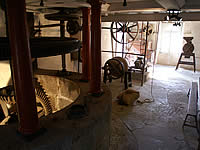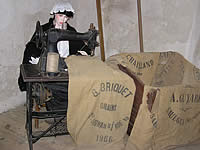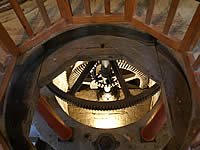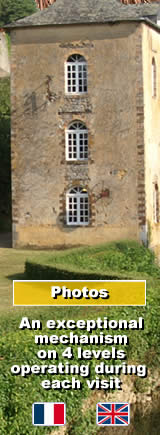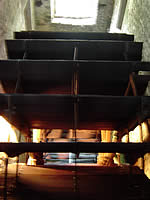 Thevalles Mill is a visit not to be missed. Situated in the heart of what was once the province of Maine, it lies in a picturesque site in the prehistoric valley of the Erve where history, heritage and the industrial revolution meet.
Thevalles Mill is a visit not to be missed. Situated in the heart of what was once the province of Maine, it lies in a picturesque site in the prehistoric valley of the Erve where history, heritage and the industrial revolution meet.
This watermill has an exceptional mechanism on 4 levels, unique in the west of France and which for the pleasure of both children and adults functions at every visit.
History of Thevalles Mill
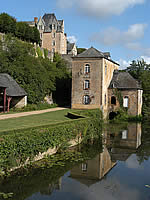 For 10 centuries, three watermills succeeded each other on the same site. The first one,
probably built around the 10th century at the time the first mills appeared on the Erve is mentioned as early as 1260. Built by the Seigneurs of Thevalles it fits into the defense plans of the castle, thus insuring the survival of the population in case of siege. In the Middle Ages the mill was accessible on only one side and solidly surrounded by the two towers of the fortress. Only the Well Tower remains today; the East Tower, which ensured the defense of the bridge over the Erve has disappeared. In 1429, the surrounding population having taken refuge in it, the castle of Thevalles was besieged by English troops. The very elaborate system of defense enabled it to resist and the English beaten by Jean de Thevalles were obliged to lift the siege.
For 10 centuries, three watermills succeeded each other on the same site. The first one,
probably built around the 10th century at the time the first mills appeared on the Erve is mentioned as early as 1260. Built by the Seigneurs of Thevalles it fits into the defense plans of the castle, thus insuring the survival of the population in case of siege. In the Middle Ages the mill was accessible on only one side and solidly surrounded by the two towers of the fortress. Only the Well Tower remains today; the East Tower, which ensured the defense of the bridge over the Erve has disappeared. In 1429, the surrounding population having taken refuge in it, the castle of Thevalles was besieged by English troops. The very elaborate system of defense enabled it to resist and the English beaten by Jean de Thevalles were obliged to lift the siege.
A second mill was built in the 16th century together with the miller's house, of which only a part still exists. Until the end of the 18th century the Thevalles Mill was not unusual - that is to say that all tenants of Thevalles were obliged to mill their grain at the mill.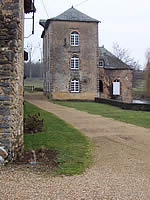
In 1850 the modernisation of the milling industry necessitated the reconstruction of the mill on four levels with a mechanism known as "english" and which still exists. At this time the mill was considered a factory as apart from milling flour it also pumped water for the Chateau gardens and was later equipped with a dynamo to produce electricity and a hydraulicaly driven pully was installed on the outside which could be harnessed to machines on the exterior. At the same period, on the other side of the river, a threshing machine for clover was installed This was the only one on the River Erve. The mill ceased activity in 1958 and since then has been conserved and patiently restored.
The mill at Thevalles is one of the sole surviving water mills which for centuries played a central role in French rural society assuring its livlihood. May the example of this era, when each village in France lived independenly teach us something of their wisdom and humility.
